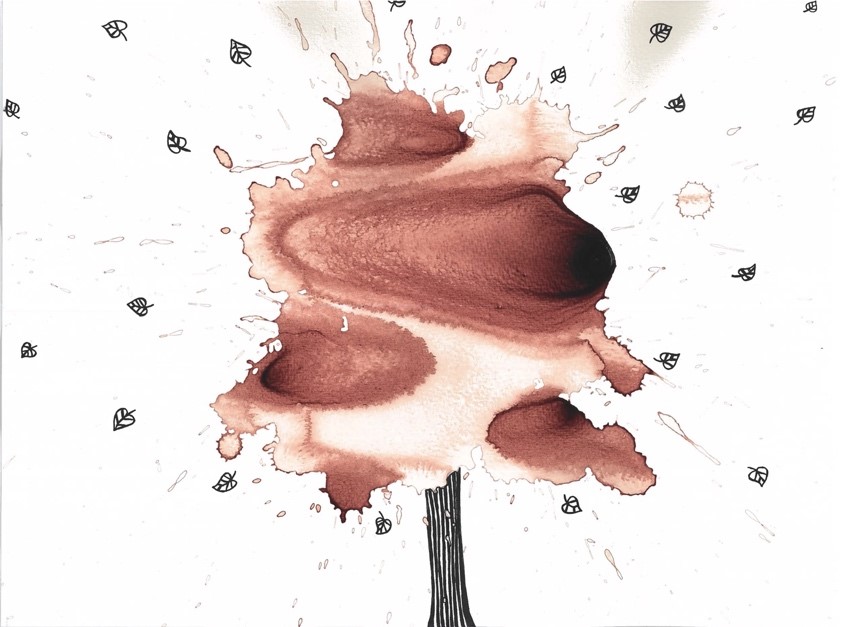Some bloody art
Miša Hejná


Why paint with menstrual fluid?
It flows.
On a monthly basis.
And as it flows it reminds us
What human life is also made of.
Euphemisms and taboos.
The crimson wave
The breath held
As I introduce my research on voice quality and the menstrual cycle to a male audience of senior academics and wave a textile pad to trap the liquid in in front of their wide-opened and still opening eyes the male audience looks
trapped
in all the fifty shades of red
claret maroon vermilion carmine chili mahogany sangria burgundy
you name it
Auntie flo is on the go
surfing the crimson wave
little months and little moons
maroon blooms in her cave
you know what and you know who
the bear we shall never mention
some say red and some say blue
strawberries ketchup
tension
a
tension
A pain
real
in the
[insert a body part]
of you /r/
own
choice
?
A seaful of wonders
A dream mayhap
Imagine the real
It’s possible
almost
My aunt hugged himself in her sleep
And we’ve all kidnapped the baby
*Fudge
it
She said
shit
poopsy daisy
a sort of hussy you know?
kind of
mistress of arts
Snowwomen of the worlds
Here’s some bloody art | for a change


Some loving and sexy voices
For the vast majority of us human animals, the voice is an integral part of who we are and how we are. One important aspect of who we are is how we do interpersonal relationships. Our voice can signal whether or not we like someone, and it can also signal who we want to attract. This may sound surprising, but research on vocal attractiveness shows this to be true. One frequent finding is that higher-pitched voices are generally perceived as more attractive in women, but not in men. And lower-pitched voices are perceived as more attractive in men, but not in women. The same individual can change their pitch depending on with whom they are speaking, including, for example, when flirting with someone they like.


So, phoneticians, too, have worked on love and sex![1] As we should. After all, whatever we love, we are. Or so Rumi tells us. But whoselove, exactly, is in the airwaves?[2] My own most immediate answer would be: everyone’s. Still, when we look at vocal attractiveness research, that’s not necessarily the impression we get. This work tends to focus on specific groups of human beings, while others are not represented very well, or, actually, not at all.
Most research findings are available primarily for speakers of Indo-European languages. More specifically, the results exist largely for a subset of these languages typically associated with the West. And, you may have guessed it, English is in the lead. For non-Indo-European languages, we typically see Japanese and Chinese. One exception is a study of work done on the group of Hadza hunter-gatherers in Tanzania. Vocal attractiveness studies are most often not done by linguistics-oriented phoneticians, for better or worse, and t. Tand this position shapes the types of questions asked.


Those of us who are linguists are likely not surprised at the under-representation of cultures as operationalised through languages. But it may seem more surprising that there is limited diversity when it comes to age, gender identity, sexual orientation, and ethnicity. Indeed, vocal attractiveness studies typically target (sometimes likely white, other times explicitly specified as white, or Caucasian) heterosexual speakers and listeners of an average age of 18-26 years. Yes, 20-24 years!
The age range makes sense, at least to some extent: much of the relevant research is fuelled by evolutionary theory, i.e. by mate selection maximising propagation of the species. Ageing studies show, however, that dating and the need for a partner is not limited solely to those who are fertile, and they are not limited to those who are 18-26 years old, either. While there is no denying that individuals who aren’t in their twenties do exist, and they certainly don’t all shy away from romantic and sexual connections, I can’t but help thinking that surely their vocal patterns may be beneficial also for the research which explicitly focuses on evolutionary theory. Would evolutionary theory expect that these individuals actually not show the same vocal patterns and preferences that we see in individuals in their twenties? With a couple of rather limited studies, we do not really know.

Similarly, we may wonder about the focus on heterosexual speakers and listeners. On the one hand, this focus seems to make a lot of sense considering the central prominence of evolutionary theory in the research at hand. At the same time, just like in the case of speakers and listeners aged beyond their twenties, what patterns emerge for speakers and listeners who do not happen to be heterosexual? Would evolutionary theory suggest that these individuals should not display the same patterns as heterosexual individuals? And what if they do? Are they supposed to show any patterns at all? And what if they do? Those results are not really available either. Yet!
Having reviewed a considerable body of the literature available (email me for references if you’d like), I can’t help wondering whose love, exactly, is expected to be in the airwaves, and whether the underlying reasons will hold when more research is carried out. Time will tell.
From Míša, with love


[1] We must bear in mind that sex and love are, of course, not the same thing, although often enough these two go hand in hand.
[2] We must bear in mind that sex and love are, of course, not the same thing, although often enough these two go hand in hand.